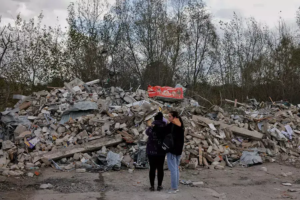This spring semester, Watson postdoctoral fellow Genevieve Bates is teaching Transitional Justice, a seminar introducing Watson students to the study of how institutions address legacies of serious human rights abuses.
Bates defines ‘transitional justice’ as broadly referring to “the policies and procedures put in place in times of transition out of periods of political violence.” She said that “traditionally, the study of transitional justice has focused on periods of transition out of authoritarian rule into democracy” but that there is some debate within the field as to whether the definition should be expanded. How broadly the term, and the legal mechanisms that accompany it, should be applied is one the major topics of discussion in the class.
Bates said, “One of the hotly contested debates in the field of transitional justice is how broad is too broad? If we bring too much to our understanding of what transitional justice is, does it make the idea meaningless?” Bates said, “Personally, I take a very broad approach to understanding it. In my mind, when I think through types of policies that get implemented in these contexts, I can’t see a difference.”
Bates said she structured the course around three main areas of transitional justice. The first is how societies hold the people who have committed atrocities accountable for their actions. The second is how societies provide support for the victims of those crimes and how to make reparations. And the third is how societies create policies to prevent future atrocities.
Bates said she wants the class to explore some of the “deep philosophical issues” that emerge from discussions about transitional justice, including, “How do we define when a transition begins? How do we know when wrongs have been righted? And with offenses as egregious as genocide or slavery, can you ever really provide justice?”
“In class right now,” said Bates, “we’re moving from focusing on personal accountability to learning about some of the other kinds of mechanisms that get implemented.” “One of the common tools used are things like truth commissions, temporary bodies set up to explore atrocities that occurred over a defined period of time,” she said. “There are also various kinds of reparations policies to compensate the victims of human rights abuses. And there are more symbolic things like memory projects and museums, which can look different from place to place,” she said.
According to Bates, these symbolic gestures can be very important. “The underlying idea is to remember what has happened to ensure that it doesn’t happen again. And also to provide victims recognition as a way of saying ‘we aren’t going to forget what happened to you,'” she said. “I think memorializing, especially large-scale abuses, can really have an impact on people, and there’s healing that can happen. At the same time, there are concerns about retraumatization, so this needs to be handled carefully,” Bates said.
Bates said she enjoys teaching Brown students. “The students are great because everyone actively engages in class, and they’re really interested in these topics, and they care about them,” she said. When asked what key thing she’d like students to take away from the class, Bates responded, “That the question of justice, especially in the wake of these kinds of atrocities, can’t be separated from the questions of power and politics. We need to think about the difficulties of trying to hold people who have done terrible things accountable, especially when those terrible people still hold power.”
— Pete Bilderback




